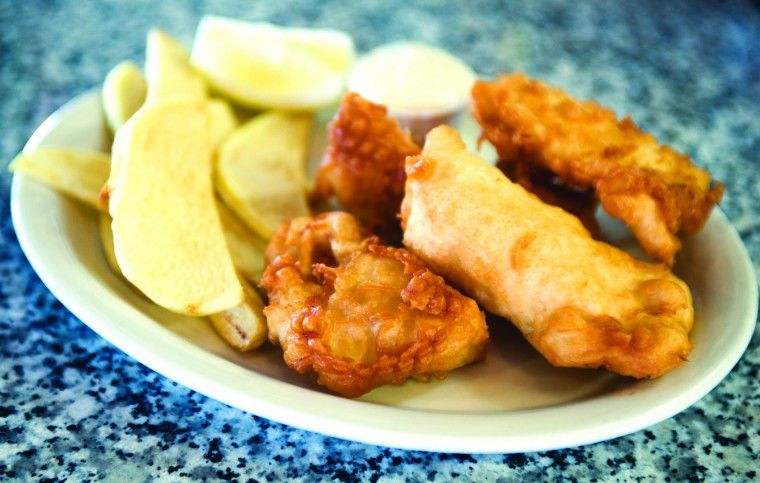Kim’s Kitchen
Published 4:50 am Thursday, September 29, 2011

- <p>Kim's Kitchen in Warrenton offers halibut fish and chips in addition to many Korean menu options.</p>
Eating at Kim’s Kitchen is a dining experience you’re not likely to get anywhere else in this area. I’m not necessarily saying that’s a good thing or a bad thing … you’ll have to decide after reading, or better yet, visiting.
If you’re looking for a fast and easy in-and-out place that will cater to your every whim, I cannot recommend Kim’s Kitchen. If you enjoy visiting a friend’s grandmother’s house and letting her whip up some recipes from the old country with what’s available in her fridge (and I do!), then this is your place. With varying hours, a menu that’s never entirely available, a difficult language barrier and prices that would be considered high at a fine-dining establishment, my immediate reaction would be to dismiss this as a place that doesn’t have it together. But once we got our food and spent some time with Kim, I realized that it would not be so easy to rate this place.
I’m reminded of a negative letter I recently published and responded to where I was accused of a great disconnect between my tastes and the tastes of my readers. I didn’t respond to that portion of the epic screed, but I’m reminded of it now as I write about Kim’s and consider the possible disconnect here, realizing there are some things I don’t mind that my readers may not put up with. While I’m always patient when one nice little old lady is running a restaurant by herself, I know a few people who would have left before the food that might have ultimately redeemed their experience was set before them. Others yet will become frustrated with communication and their inability to convey that they don’t want this and they want that on the side. Roger Ebert once wrote of a movie I liked: “I can’t recommend it, but I would not for one second discourage you from seeing it.”
That’s kind of how I feel here. Kim’s won’t technically “work” as a restaurant for many people, but it works for me, and I’m recommending it. By the time you’re done reading, you’ll know if it’s for you or not.
I’ve mentioned Kim’s homemade kimchi in past articles. She sells it to customers and local restaurants, and its quality makes it the recipe all others must live up to. I’ve always got some in my home refrigerator. For those uninitiated, kimchi is a traditional Korean spicy fermented cabbage dish. No two preparations are the same, and they vary greatly by season, region and ingredients.
Kim was always out of several dishes or ingredients, different on each of my visits. Since I’ve never seen another table of guests, not only on my recent visits, but any other time I’ve stopped in to refill my kimchi jar, I know she’s not too busy, and plays it close with the ingredients. But buying less of good fresh and and local food and selling it out is far preferable to stocking your freezer with ready-mades (see last week’s column) that will last the duration.
And even with patient reiteration of your order and pointing to the menu, you’re likely to be served something different anyway. On one visit, we ordered the chicken stir-fry. After she told us she was out of chicken, we ordered a beef stir-fry and a pork stir-fry and a couple things to go. We went over and over the order, mostly because she wanted to make sure it was right. More than 20 minutes later, she brought out our dinner: two chicken stir-fries. But by then it was funny, and we were hungry, and it was delicious. Tender chunks of marinated light and dark meat sat among zucchini, al dente green beans, Japanese eggplant, carrots, onions, bell peppers and scallions, in a flavorful garlic and ginger sauce with steamed white rice and kimchi on the side. While $16.75 is far too steep for such a dish, I took some solace in having heard her chop all of the vegetables fresh, knowing we were truly getting a scratch-cooked meal.
The next time, I sampled the beef bulgogi and the pork bulgogi (both $18.75). The beef was thinly sliced rib-eye, marinated in a sweet and savory garlic sauce. The marbling of the beef and the marination made for a fork-tender texture, as the dark sear on the outside of the meat enhanced the overall flavor profile. The pork had a slightly more spicy, less sweet marinade, but was equally tender and tasty. Hot and spicy chicken ($17.75) is also a fantastic marinated meat dish. Its bright red exterior looks like a warning, but this tender chicken wasn’t burning hot. All Korean dishes are served with rice and kimchi.
One thing that will be too hot for all but the toughest of the pepper-bellies is the kimchi soup ($16). This is kimchi, a very spicy broth, tofu and pork. I loved the dish, but even at more than a quart, the price doesn’t reflect the ingredients or work put into it.
On the seafood and American menu, it’s mostly fried seafoods with choice of fries, baked potato or rice. Fries are from the freezer, and baked potatoes weren’t available, but this seafood is so fresh and perfectly fried in a light tempura that it doesn’t matter what side you get. Here, the portions are big enough to almost justify the prices. Fish and chips ($22) feature four large pieces of halibut, a good dish to share. Prawns ($25) were large, butterflied and overflowing on the plate. Again, unless you can eat that much, I recommend sharing. For $30, you can get scallops, halibut, salmon, oysters and prawns, which come with a unique ginger and horseradish tartar sauce. For true fans of tempura, Kim’s is the place to go.
While a little effort is necessary of the customer, there’s much to love about Kim’s, namely Kim herself. She lights up when you tell her how good her food is. She doesn’t hear too well, and doesn’t do too well with the English, but she genuinely cares about making you happy. It’s her kitchen, and you truly feel a welcome guest in it. Does anybody disagree with that?





